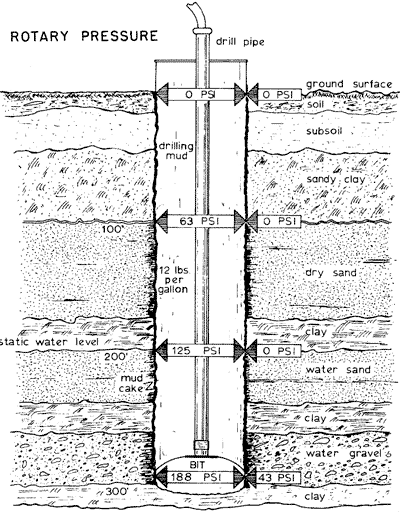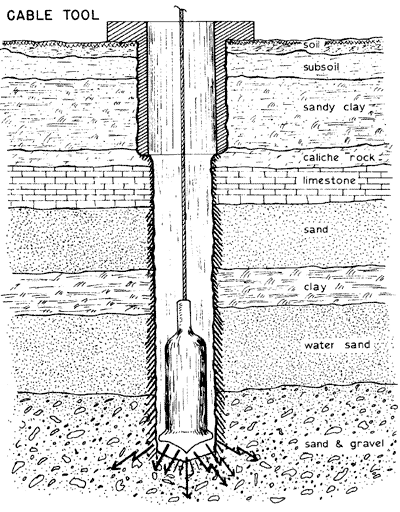What Makes a Good Water Well
There are three main ingredients that go into making a good water well: drilling, pumping and developing. The first two are indispensable since an opening of some kind has to be made in the waterbearing formation and some means must be supplied for lifting the water to the surface, even if it's only a bucket tied to the end of a rope.
Various drilling methods may include: direct and reverse circulation, rotary, cable tool, scow, driven points and even hand dug wells. Added to this we have: running the casing, setting the screen, strainer or liner, cementing, undereaming, gravel-packing and all other work done in connection with the construction of the hole.
For pumping we can include all means of artificial lift, such as deep well turbine, jet, rod, submersible, centrifugal and other pumps. We can also include air-lift and natural artesian flows.
The third ingredient, the development of the well, is too often neglected. For example, wells are drilled, a pump installed and whatever flow obtained is accepted even though it may not be what is needed or desired. Many conclude that this is all the water available from the formation. Our experience at Cotey Chemical reminds us that this conclusion is probably not true and that the flow could be increased with proper development.
Developing the Well to its Maximum Capacity
Mechanical methods used for developing water wells include: bailing, pumping, back washing or back lashing with the pump, surging with a surge block or with compressed air, using explosives, jetting, and fracturing. In all these mechanical efforts to open up the perforations by force, pressure is applied from the well bore out into the formation. This is the same direction pressure was applied during the drilling operation, plugging some of the water pathways in the process.
In order to drill, a fluid is usually circulated to remove the cuttings and stabilize the hole. In most cases mud is considered the fluid of choice. Commercial drilling mud can be purchased and used for this purpose. Or, as happens in many wells, enough natural-occurring clay exists in the formation to form the needed mud as drilling progresses. Mud should also be the proper type and consistency. If the mud is too thin, circulation may be lost and all the mud will go back into the formation making it difficult to remove later. If the mud is too thick it becomes heavy and harder to circulate and will tend to stick the bit.

The "Rotary Pressure" illustration shows some of the results when a well is drilled with the rotary method. These will occur whether the drilling is by direct or reverse circulation. When considering the pressures and methods used to drill it seems apparent that, for all practical purposes, it is almost impossible to drill a well without plugging off at least some water.
After the well is drilled all the mud cake must be removed if the well is to be developed to its maximum capacity. According to the illustration, at the static level of 200 feet, mud was put in place with 125 psi pressure; at 300 feet, 188 psi. After most of the mud has been removed from the well by bailing or pumping there is normally some left on the wall of the hole and in the formation. The only available means to push the mud off the wall and/or out of the formation is the head pressure of the water in the formation. At the static water level of 200 feet there is no head pressure. At 300 feet the maximum pressure would be only about 43 psi and this is only if the formation had uniform vertical permeability - which is rarely if ever found. There usually will be several clay or shale breaks which will reduce the total pressure.
So we now have the following condition - mud put in place under 125 psi at the static water level and no water pressure to remove it, and mud put in place under 188 psi at 300 feet with at most only 43 psi water pressure to push it out. Naturally, the deeper the hole and the less standing water there is, the greater the differential pressure.

With cable tool or spudder drilling, the same thing occurs but the pressure is applied in a different manner. The "Cable Tool" illustration shows roughly what happens. As the heavy tool is raised and dropped a tremendous force is developed on the face of the bit. This force acts in a direction at right angles to the face of the bit. As a result, as drilling progresses, the formation around the well bore is compacted and the mud and slush in the hole is pounded back into the formation. Here again, the only pressure available to remove any plugging is the water head pressure in the formation. This pressure will never be anywhere near the pressure used by the heavy tool string. Scow drilling, driving casing and reaming also have similar action which tends to plug off some water. The effect of this plugging is lower water flow and lower specific capacity.
In a sand and gravel well, mud-cake ends up on the wall and in the formation compacted around the well bore. Since this is behind the casing or screen and behind the gravel pack, purely mechanical means will not be effective in removing it. In order to get maximum capacity all the mud must be removed and the formation opened up to allow water to flow freely from the formation into the well bore.
The combination of properly-used chemical treatments and mechanical agitation methods are quickly gathering acceptance as the most effective process for removing mud and opening perforations and water-bearing formations.
Recognizing this, a great many chemicals have been dumped into wells in an effort to clean them up. Various acids have been used, soaps, detergents similar to household cleansers, watersoftening chemicals, chelating agents, wetting agents, carbide and, believe it or not, Alka-Seltzer.
But, for a chemical treatment to work, the chemistry must match the problem. For example, some chemicals must be effective in dissolving, disintegrating and dispersing commercial drilling muds, clays and shales so that they can be easily bailed or pumped to waste. Others should be capable of dissolving limestone and waterdeposited scales, corrosion products and organic growths.
Additionally there are requirements that any chemical should meet if it is to be used in a water well: It should be relatively non-toxic and should not contaminate the water; it should be safe to use on mechanical equipment in the well; it should also be safe and easy to handle. Finally, from the contractor or well service company standpoint, chemical treatments should be services that can be performed without the need of additional equipment.
With chemicals that have been developed specifically for treating water wells, it's now possible for a contractor or well service company to include chemical treatment along with their other services, adding additional profit to a job and making a better well for the customer.
Finally, before any chemical treatment will even be considered, the fact must be admitted or established that some water pathways were probably plugged during drilling. Some drillers may be reluctant to admit this possibility, considering it a negative reflection on their ability. Others claim that if the water is there they will get it. This is not always true. Many older wells made more water after chemical treatment than when first completed, showing that some water pathways had been blocked from the beginning. Obstructed water pathways is often just a function of drilling and bears no reflection on the drillers ability.
DRY ACID® is a Cotey Chemical product specifically blended to help develop water wells to their maximum capacity. It is designed to remove clays, shales, drilled cuttings and commercial drilling muds from water wells. It is also excellent for "gravel-slipping" and freeing stuck drill pipe. DRY ACID® will effectively prevent mud-cake build-up if used during well drilling or will quickly remove mud-cake after the well has been drilled. Also, DRY ACID® is better than the oftenused canister of single phosphates thrown down the well to "clean out the muds". This is because single phosphates act as a food source for algae and there's nothing in the phosphates that will control this algae or sterilize the well. DRY ACID®, besides simply dissolving mud and attacking carbonate content in the well, will also completely sterilize the well, certainly a tertiary benefit of major importance and at minimal cost.
After the well is completed, DRY ACID can be used to break down whatever "mud-cake" is produced during the drilling operation. This mud-cake, consisting of fine silts and clay particles, is often partially cemented or consists of minute calcium carbonate fragments. Standard treatments using acid may aggravate rather than correct the problem. The acid-dissolving cations present in the clay allow free silicone dioxide (Silica, SiO2) to precipitate out as a gel instead of dissolving it. DRY ACID not only dissolves the mud-cake but acts as a strong sequestering agent preventing silt and clay particles from precipitating or flocculating out of solution. DRY ACID may even be used to redevelop older wells produced in sand and/or gravel formations to their original flow or greater.
For wells developed in areas where carbonate is not a problem, mud-cake, silts and clays and even oil from oil-lubricated turbine pumps can be removed with Cotey Chemical's MUD-NOX. MUD-NOX is a superior wetting agent and emulsifier that disperses silts and clays, allowing the particles to be pumped to waste instead of collecting in the well. The emulsification properties ensure that any oil in the well will mix with the water to be pumped to waste. MUD-NOX also disperses mud during the bailing process and may be used as a drilling additive to reduce solids build-up, decrease friction, aid in suspending solids and help remove mud-cake, silt and clay from the well during the drilling process.
As a multi-purpose surfactant/polymer with a broad range of useful applications, MUD-NOX is an excellent addition to Cotey's DRY ACID for getting all the water possible from the drilled well.
